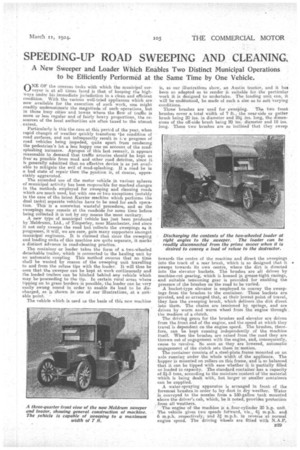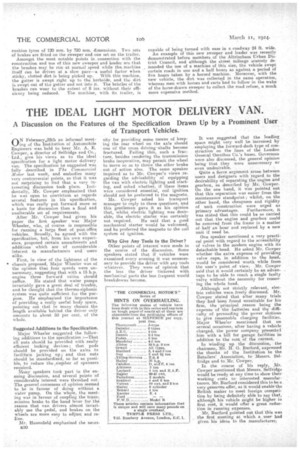SPEEDING-UP ROAD SWEEPING AND CLEANING.
Page 13

Page 14

If you've noticed an error in this article please click here to report it so we can fix it.
A New Sweeper and Loader Which Enables Two Distinct Municipal Operations to be Efficiently Performed at the Same Time by One Vehicle.
(INK OF the onerous tasks with which the municipal sur veyor is at all times faced is that of keeping the highways under his immediate jurisdiction in. a clean and efficient condition. With the various well-tried appliances which are now available for the execution of such work, one might readily underestimate the magnitude of such. operations, but in those busy cities and towns where the flow of traffic is more or less regular and of fairly heavy proportions, the resources of the local authorities are often taxed to the utmost extent.
Particularly is this the case at this peried of the year, when rapid changes of weather quickly transform the condition of road surfaces, and not infrequently result in t.•e progress of road vehicles being impeded, quite apart from rendering the pedestrian's lot a less happy one on account of the mudsplashing nuisance. Apropos of this last remark, it appears reasonable to demand that traffic arteries should be kept as free' as possible from mud and other road detritus, since it is generally admitted that no effective device is as yet available to mitigate the evil of mud-splashing. If a road be in a bad state of repair then the position is, of course, appreciably aggravated.
The extended use of the motor vehicle in various spheres of municipal activity has been responsible for marked changes in the methods employed for sweeping and cleaning roads which are much used, but with one or two except-ions. (notably in the case of the latest Karrier machine which performs the dual tasks) separate vehicles have to be used for each operation. This is a somewhat wasteful procedure, and as the sweepings may remain at the roadside for some time before being collected it is•not by any means the most sanitary. A new type of Municipal vehicle has just been produced by Meldrums, Ltd., of Timperley, near Manchester, and since it not only sweeps the road but collects the sweepings as it progresses, it will, we are sure, gain many supporters amongst municipal engineers. It is claimed that since the sweeping and loading units of this machine are quite separate, it marks a distinct advance in road-cleaning practice.
The container or loader takes the form of a two-wheeled detachable trailer, • which is connected to the hauling unit by an automatic coupling This method ensures that no time shall be wasted by reason of the sweeping unit travelling to and from the refuse tips with the loader. It will thus be seen that the sweeper can be kept at work continuously and the loaded trailers can be hitched behind any vehicle which may be-proceeding to the tip. In certain rural areas where tipping on to grass borders is possible,the loader can be very easily swung round in order to enable its load to be discharged, as is shown in one of our illustrations, at a suit able point. ' • The vehicle which is used as the basis of this new machine is, as our illustrations show, an Austin traetor, and it has been an adapted as to render it suitable for . the particular work it is designed to undertake. The loading unit can, it will be understood, be made of such a size as to suit 'varying conditions.
Three brushes are used for sweeping. The two front brushes cover a total width of 7 ft., the near-side or gutter brush being 20 ins, in diameter and 25i ins, long, the dimensions of the off-side brush being 20 ins.diameter and 18 ins. long. These two brushes are so inclined that they sweep towards the centre of the machine and direct the sweepings into the track of a rear brush, which is so designed that it sweeps towards its own centre, where the dirt is directed into the elevator buckets. The brushes are all driven by machine-cut gearing, which is housed in grease-tight casings, and suitable tensioning gear is provided for enabling the pressure of the brushes on the road to be varied. A 'bucket-type elevator is employed to convey the sweepings •from the brushes to the container. These buckets are pivoted, and so arranged that, at their lowest point of travel, they face the sweeping brush, which delivers the dirt direct into them. The chains are tensioned by springs, and are driven by worm and worm wheel from the engine through the medium of a clutch.
The driving gears for the brushes and elevator are driven from the front end of the engine, and the speed at which they travel is dependent on the engine speed. The brushes, therefore, can be kept running independently of the machine itself. When the brushes are raised from the road they are thrown out of engagement with the engine' and, consequently, cease to revolve. So soon as they are lowered, automatic engagement of the clutch sets them in motion.
The container Consists of a steel-plate frame mounted on an axle running under the whole width of the appliance. The hopper is mounted on rollers on this frame, and is an balanced that it can be tipped with ease whether it is partially filled or loaded to capacity. The standard container has a capacity of 2i-.3 tons according to the moisture content of the material which is being dealt with, but larger or smaller containers can be supplied. A water-spraying apparatus is arranged in front. of the foremost brashest in order to lay dust in dry weather. Water is conveyed to the nozzles from a 150-gallon tankmounted above the driver's cab, which, be it noted, provides protection from all weathers.
The engine of the machine is a. four-cylinder 20 h.p. unit. The vehicle gives two speeds forward, viz., 4 m.p.h. and 6 m.p.h. respectively, and 32m.p.h. in reverse at normal engine speed. The driving wheels are fitted with N.A.P. cushion tyres of 120 mm. by 720 mm. dimensions. Two sets of brakes are fitted on the sweeper and one set on the trailer. Amongst the most notable points in connection with the construction and use of this new sweeper and loader are that the brushes may he run at normal speed while the, machine itself can be driven at a slow pace—a useful factor when sticky, clotted dirt is being picked up. With this machine, the gutter is swept right up to the kerbside, and the dirt is swept out of the gutter and not into it. The bristles of the brushes can wear to the extent of B ins, without their effi ciency being reduced. The niachine, with its trailer, is capable of being turned with ease in a 'roadway 24 ft. wide.
An example of this new sweeper and loader was recently demonstrated before members of the Altrincham Urban District Council, and although the street mileage scarcely demanded the use of a machine of this size, the vehicle swept certain roads in one and a half hours as against a period of five hours taken by a horsed machine. Moreover, with the new vehicle, the dirt was collected in the same operation, whereas men with horses and carts had to follow in the wake of the horse-drawn sweeper to collect the road refuse, a much more expensive method.
































